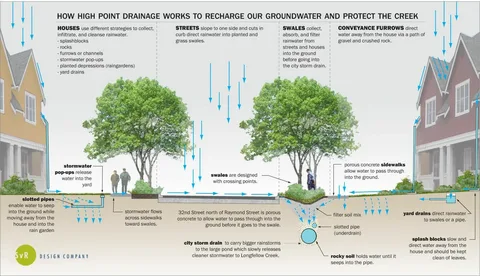Water management problems rarely show patience. Drain failures, pooling, and foundation pressure build fast, which is why choosing the right team matters more than speed alone. Anyone searching drainage companies near me should know that skill, documentation, materials, and accountability dictate whether a drain system works for 5 years or 50.
Proof of Experience with Surface and Subsurface Water Redirection
Surface and subsurface water behave differently, requiring separate engineering approaches. The best crews demonstrate experience designing yard catch basins, swales, downspout dispersion, and below-grade perforated pipe networks that manage hydrostatic pressure. Each solution only works when paired with correct soil analysis, slope calculations, and water exit strategy—not guesses.
A company must show projects where redirected water stayed redirected, not resurfaced somewhere else. Photos of trench depth, junction connections, and discharge termination points reveal training, not marketing claims. Any team offering drainage solutions as a side service instead of a primary skill is a risk when dealing with heavy seasonal flow in Huntsville AL.
Verifiable Track Record Installing Long-lasting French Drain Networks
French drains look simple but fail quickly when assembled without design precision. The difference between a short-lived install and a 20-plus year system is pipe diameter choice, bedding uniformity, filtration fabric overlap, aggregate size, and outlet positioning. Evidence of completed French drain networks that survived storm cycles carries more weight than sales promises.
Credibility also shows in documented follow-ups after extreme weather seasons. A company should be comfortable sharing references where drain performance was measured after peak rainfall. A real French drain should prevent soil washout, yard erosion, and foundation seepage without repeated clogged drain service calls.
Transparent Service Response Time for After-hours Blockages
Every drainage system should include a clear emergency response policy. Blockages don’t respect schedules, so knowing how a provider handles urgent calls for emergency drain service is essential. Response time outlined in writing distinguishes serious providers from unreliable dispatch services.
A vague “call us anytime” has no accountability. Expectations should be defined in measurable time windows, especially for post-storm backups or unexpected groundwater surge. Fast arrival only matters when paired with diagnostic equipment, clearing tools, and authority to resolve the problem immediately—not schedule a later appointment.
Material Standards for Pipes, Bedding, and Filtration Components
Materials determine lifespan more than labor hours. Premium drainage builds rely on solid or perforated HDPE or PVC pipe, clean aggregate bedding, and non-decomposing geotextile fabric for filtration. Cheap corrugated pipe with no filter wrap encourages root intrusion, sediment takeover, and repeat drain clearing service needs. Stone gradation matters just as much. Correct installations use washed stone of consistent size to maintain void space for water flow, unlike mixed gravel that compacts and chokes the system. Companies should explain their materials with specifications, not general labels like “drain rock” or “hard pipe.”
Evidence of Proper Grading Practices to Protect Landscaped Areas
Drainage installation must fix water movement without destroying yard topography. Proper grading relies on measured slope percentages, surface contour transitions, and preservation of landscaped areas when possible. A skilled team routes water away while keeping beds, lawns, and hardscapes functional. Fixing water issues should not create new problems like trench dips, sink lines, or soil heave. Finished grading should look intentional, smooth, and visually undisturbed despite the underground work. Understanding grading as both functional and aesthetic separates drainage professionals from trench-digging labor crews.
Drain Mapping Methods Used to Document System Layout
A modern drainage system should never become an underground mystery. Drain mapping—using measurements, GPS pins, site schematics, or traced layouts—documents where pipes run, where connections sit, and where access points are positioned. This reference prevents accidental damage during future improvements like fences, irrigation, or landscaping.
Mapping also protects homeowners from costly guesswork when servicing the system later. A drain is only maintainable when its route is known. Without documentation, even simple line clearing becomes a blind excavation exercise instead of an efficient service call.
Clear Warranty Terms for Trenching, Pipes, and Installation Work
A warranty is only as good as its clarity. Strong agreements separate coverage by component: trench stability, pipe integrity, labor workmanship, and system function. Vague “one-year guarantee” language benefits the installer, not the property owner.
Coverage should explain what voids the warranty, what service response looks like, and whether labor or materials are protected independently. Reliable drainage providers do not hesitate to put these terms in writing because the work is designed to last, not fail early.
Cleanup Process and Site Restoration Included in the Scope
Drain installation reshapes a property. Responsible providers restore lawns, grade soil evenly, remove excess materials, and leave the site visually finished. Cleanup is not an add-on favor—it is part of completing the job correctly.
Debris piles, exposed trenches, and uneven fill invite erosion, trip hazards, and reseeding costs. Restoration should include recompaction, soil settlement planning, and final surface smoothing so grass, sod, or ground cover can recover predictably.
High-functioning drainage protects the property long-term, but the installation process shouldn’t punish the homeowner in the short term. Companies that treat site restoration as standard reveal the difference between simply offering a drain service near me and delivering a project with real accountability. Cora Landscape has the kind of infrastructure and specialization that fits the demands of engineered French drain systems.

